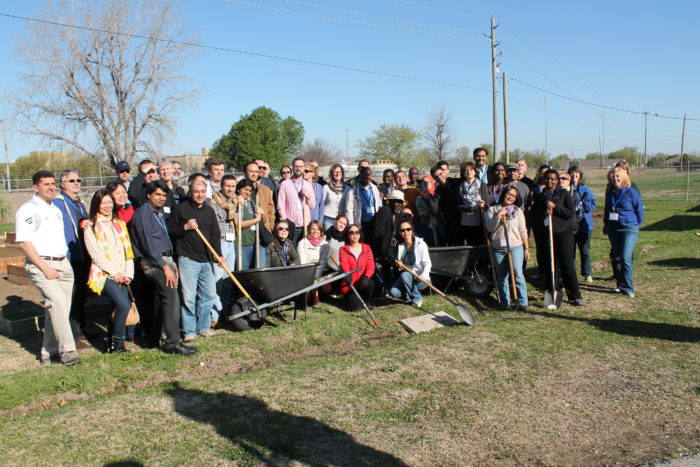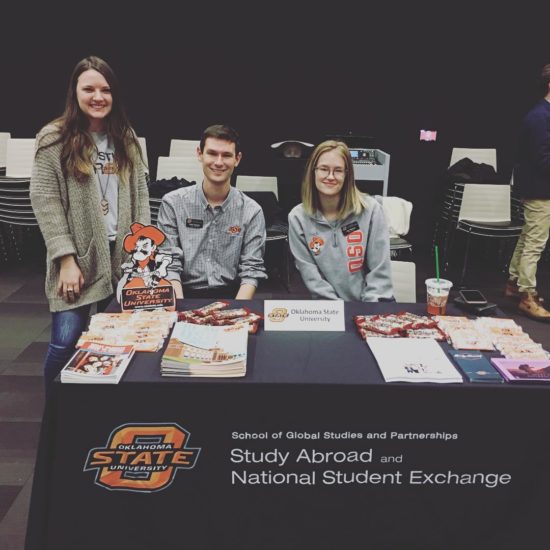By Bob Lieser, Vice President of Programs, Tulsa Global Alliance
 Tulsa Global Alliance (TGA) is located on the Oklahoma State University – Tulsa campus and enjoys mutually beneficial relationships with several other local universities. The impact of these relationships on us, the university community, and exchange participants is undeniable:
Tulsa Global Alliance (TGA) is located on the Oklahoma State University – Tulsa campus and enjoys mutually beneficial relationships with several other local universities. The impact of these relationships on us, the university community, and exchange participants is undeniable:
- International students at area universities have opportunities to gain hands-on experience in community service at TGA events. Past international visitors have handed out water to runners at the Tulsa Run, spoken about their countries to children at global education festivals at schools and libraries, and served as greeters at fundraisers and international food tasting fairs.
- When universities host IVLP groups and other U.S. government international exchange participants, they are reaching out to potential contacts that can help recruit future international students to their campuses.
- CBMs can serve as a focal point for the international activities of universities and their international students. For example, TGA is made more aware of what the universities are doing and their global outreach and impact.
- In 2020, an Oral Roberts University (ORU) campaign strategies class assisted TGA with fundraising, host family recruitment, and social media. Each semester this class works with a different nonprofit, and TGA’s relationship with ORU helped in our selection.
- As a result of partnerships with CBMs, universities learn about the national role of Global Ties U.S. For example, Oklahoma State University students and professors in Global Studies have attended the Global Ties U.S. National Meeting as part of the TGA delegation.

Fulbright Scholars volunteer at the Community Food Bank of Eastern Oklahoma. Photo provided by Tulsa Global Alliance
In order to maintain these mutually beneficial relationships, TGA’s strategic plan includes goals of promoting partnership opportunities, programming, and internships with area educational institutions. We achieve these goals by:
- Promoting international activities of area universities through social media and e-newsletter, and sharing the newsletter with universities.
- Providing unpaid public diplomacy internships to university students, and working with university faculty, work-study and study abroad offices to promote these opportunities. Interns often pursue careers in international relations, and make valuable contacts through TGA with leaders in government, business, and other fields.
- TGA staff serving as guest lecturers at Oklahoma State University’s public diplomacy classes. Several students have applied for TGA internships as a result.
- Offering programmatic expertise on international projects. For example, TGA arranged volunteer opportunities and meetings for students from the University of Tulsa’s partner university, China Petroleum University in Beijing.
- Collaborating with area universities on U.S. government-funded grant opportunities when possible. TGA and the University of Tulsa hosted Fulbright Enrichment programs, and TGA arranged meetings for Tulsa Community College’s Fulbright Scholars.
- Organizing a study abroad fair at the Tulsa City-County Library for universities to highlight international opportunities for potential students. TGA publicized this event to local high schools.
- Honoring area colleges and universities with TGA’s annual Global Vision Award for significant and lasting contributions to citizen diplomacy. This raises TGA’s profile in the higher education community and has resulted in individual and corporate memberships from universities and their staff.

Oklahoma State University staff at the Tulsa Global Alliance Study Abroad Fair. Photo provided by Tulsa Global Alliance.
For CBMs looking to establish higher education partnerships, here a few tips:
- Find a partner your CBM can work with at each university, perhaps a faculty member or administrator. Invite them to serve on your CBM’s board of directors.
- Make a list of what your CBM can offer to universities and their students – for example, an international outlet to returned study abroad students, or opportunities for U.S. students to meet their international counterparts and learn about international careers.
- Research area universities, where their international partnerships are, and what countries they would like to work with, and try to find IVLP higher education projects or alumni from these countries for them to meet.
